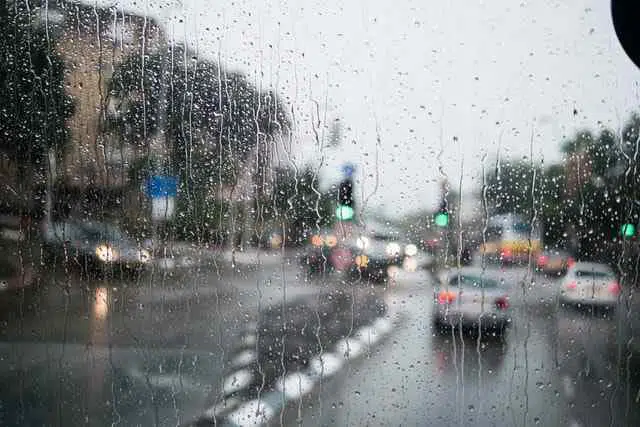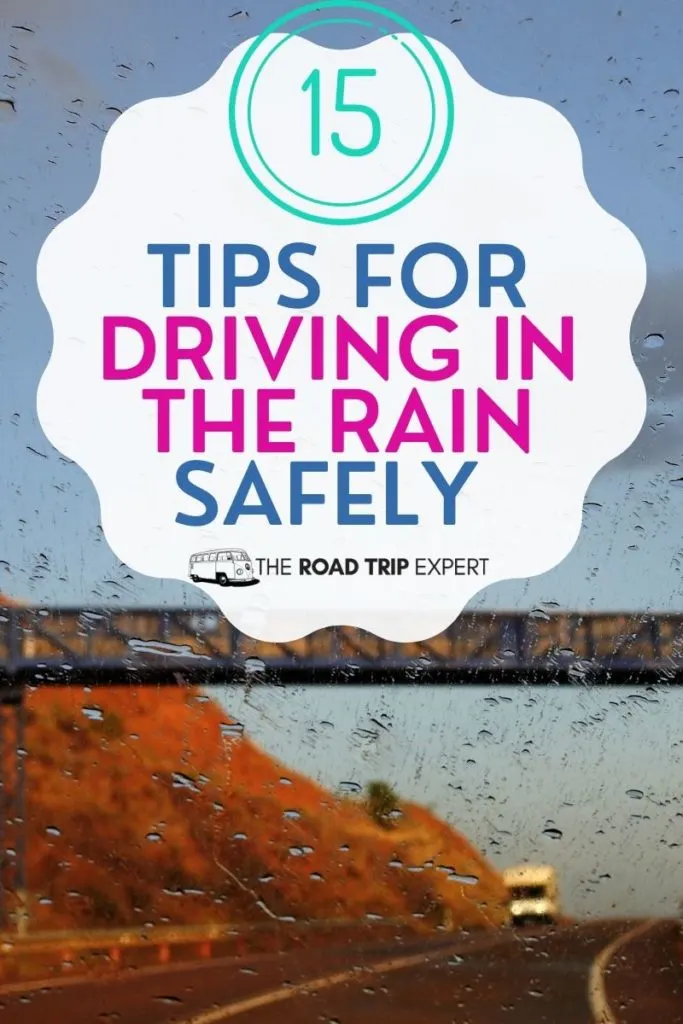It can be difficult to drive in the rain safely because of the slick roads, low visibility, threat of hydroplaning, and the possibility of becoming stranded in a flooded section. It is important to slow down and leave plenty of room between you and the car in front of you so you have plenty of time to assess and react to hazards.
This guide will explain how to drive in the rain safely so that you have an enjoyable journey.
Whether rain is seasonal, year-round, or rare where you live, you want to make sure both you and your car are safe. Be safe driving in the rain by thinking ahead and taking things slow.
Why is it dangerous to drive in the rain?
Driving in the rain is dangerous because you are more likely to lose traction on the road. Loss of traction can cause an accident as you may lose control of the vehicle. Braking distances are also increased and visibility is reduced meaning you have less time to react to hazards. Hydroplaning can also occur which presents further risks.
Affiliate Disclosure: Thank you for supporting The Road Trip Expert. When you purchase through links on this site, we may earn an affiliate commission. Please see our advertising disclosure for more details.
Avoid driving in bad weather if you can
You can drive in the rain safely by avoiding all non-essential travel. We all need to get to work, pick up the kids, or possibly check in on elderly family members. We do not need to go out for a coffee in the middle of a rainstorm. If you can stay home, do.
Know the weather in your area
If you have a rainy season, be prepared for it ahead of time. Give yourself time to check the weather in the morning before leaving the house.
Check the vehicle before driving
Make sure your vehicle is ready to drive in the rain before you get behind the wheel.
- Lights– Take the time to check that the lights are bright and working.
- Bakes– Check that brake pads have not worn down below the recommended level and be mindful of your brakes when driving. If they are squeaking, feel soft, or unresponsive, definitely get them checked out.
- Tires– Tires should have good tread and be properly inflated according to your car’s user manual.
- Wiper Blades– Test out your your wiper blades to ensure they are in proper working order.
These things can take time and obviously need to be fixed ASAP if they aren’t in perfect working order, so don’t wait 5 minutes before you head out to check them!
Be prepared for a breakdown
A breakdown can and eventually will happen. Make sure you have an emergency roadside kit to keep you safe, especially when you have to drive in the rain.
We recommend the FS Car Emergency Safety Kit Bag as it has all the items you’ll need in an emergency at the best quality.
- Quality Materials: Our Car Emergency Kit is packed…
- 90-Piece Premium Roadside Assistance Set: Our kit…
- Additional Kit: We’ve included only the best tools…
Leave plenty of space between you and the car in front of you
Increased braking time and reduced visibility are the two main reasons to maintain distance from other cars. You should leave more distance than usual and prepare for unexpected braking.
Even in the best of driving conditions, you should be leaving a 3-second delay between you and the car in front of you. This means that once the car in front of you has passed a marker (a billboard for example) there should be 3 seconds from when their rear bumper leaves the marker before your grill meets it.
To drive in the rain safely, you should add 1 second of space for every adverse driving condition you are facing. So if it is dark and rainy, add 2 seconds.
Reduce your speed
You should slow down when it’s raining due to the reduced visibility and increased braking time. Wet tires have less traction on the road meaning it takes longer to stop the car when required.
It is recommended that you reduce your speed by 33% when it is raining. Roads can become slick with water and oil leaching out of the street. To drive in the rain safely, you want to give yourself the maximum amount of time to react to any potential hazards.
Avoid heavy braking
Stomping on the brakes is the last thing you want to do when you drive in the rain. It could cause your car to lose traction with the road and hydroplane. You should be driving at reduced speeds with increased space between you and the car in front of you. This allows you time to slow down by easing off the gas pedal before applying the brakes.
Drive with headlights on
Use your headlights to alert other road users to your presence. When it’s raining it can be more difficult to accurately establish the distance between vehicles. During heavy rain, visibility can be significantly reduced so headlights are strongly advised for a safe driving experience.
Rainy days can decrease visibility, both your ability to see and others’ ability to see you. When you drive in the rain, keep your headlights on to make yourself easier to spot. Resist using your high beams/brights as this can blind other drivers and have the reverse effect.
Check your windshield wipers
To drive in the rain safely, you want to keep your windshield wipers running. Most cars come with 3 speeds, so set the frequency at an appropriate speed to keep your windshield as clear as possible.
Prevent windows from fogging up
Rain increases the moisture in the car and makes it much more difficult to keep windows clear. Keep the inside of the windows clean, circulate fresh air, and use those defrosters! You may want to consider using an anti-fog product like Rain-X Interior Glass Anti-Fog to drive in the rain safely.
- Reduced interior fogging
- Improved visibility
- For automotive and marine interior glass and…
If you struggle with foggy windows, we’ve got more advice on How to Stop Car Windows from Fogging Up.
Be aware of traffic issues
Minimize distractions in the car and keep scanning the road ahead of you for brake lights or sudden stops. When driving in the rain, it is a good safety tip to have a local news station as one of your saved radio stations so you can easily check-in for any important traffic updates.
Give the right of way
While you may be doing your best to drive safely, other drivers may be impatient or oblivious to the rainy day driving hazards. Give these drivers plenty of space and give them the right away; it is better to maintain your safety and peace of mind than to get caught up in road rage.
Turn around, don’t drown
Look out for standing water! Standing water is dangerous because you have no idea how deep it is and running across it at full speed can cause you to hydroplane or worse: sink. Avoid large puddles and stop and turn around if an entire section of the road is submerged in water.
If you hydroplane, don’t panic
Losing control of the car is a horrible feeling, but don’t let it cause you to lose control of yourself. Stay calm and alert; ease off the gas and keep the car steered toward the direction you want to go. Avoid slamming on the brakes. Once your car has regained traction, you can begin to work the gas and brake pedals to regain control of your speed.
Know your limits
Maybe you set off and the rain wasn’t so bad, or you underestimated how low visibility might be once you were driving at speed. Whatever the reason, do not be afraid to admit that you have reached your limit. If you find yourself panicked, gripping the steering wheel, barely able to see 5 feet in front of your car, it’s time to find a safe place to pull over and wait it out. Remember, you’ll be a lot later if you’re dead!
You can find more advice on how to drive safely in our Road Safety Tips post.

Disclosure: Some of the links in this article may be affiliate links. This means I earn a commission if you make a qualifying purchase, but this is at no additional cost to you. Thank you for supporting The Road Trip Expert.




